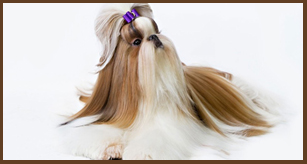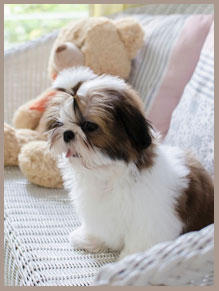Meet the Shih Tzu: A Happy Companion With a Noble Past
 Those of us who have been involved in the breed for a long time remember well the things that first attracted us to the Shih Tzu. Most of all, the Shih Tzu is happy, even-tempered, and eager to please—with just a touch of arrogance, as befits his former role as a companion in the Chinese royal court.
Those of us who have been involved in the breed for a long time remember well the things that first attracted us to the Shih Tzu. Most of all, the Shih Tzu is happy, even-tempered, and eager to please—with just a touch of arrogance, as befits his former role as a companion in the Chinese royal court.In fact, the Shih Tzu’s sole purpose throughout history is that of a loving and loved companion. He gets along well with children and other dogs, and is perhaps likely to give even a burglar a guided tour. He is also sturdy and solid, despite his relatively small size. This makes him well suited to modern life in city or country, and to a wide range of companion and performance sports as well as conformation events. These characteristics should be evident in the show ring as well as at home. A Shih Tzu should move proudly and efficiently around the ring, with his head up and his teacup-handle tail wagging.
 This is also a glamorous breed, with a long, flowing double coat. This is not a single-coated breed, but the really dense, cottony undercoats that refuse to flow despite much application of product and flat iron and mat when you look at them cross-eyed are a blessing to neither dog, nor groomer, nor owner!
This is also a glamorous breed, with a long, flowing double coat. This is not a single-coated breed, but the really dense, cottony undercoats that refuse to flow despite much application of product and flat iron and mat when you look at them cross-eyed are a blessing to neither dog, nor groomer, nor owner!The website of the breed’s national parent club, the American Shih Tzu Club, offers a wealth of information for owners, including advice on grooming the companion dog.
The Shih Tzu coat comes in many colors. Every breeder has his or her preference(s), but all colors and markings should be considered equally by judges.
Perhaps the most distinctive feature of the Shih Tzu is his warm, sweet, wide-eyed, friendly, and trusting expression. This should result from a combination of a large, round head; full dark eyes placed well apart; a square, short, well-cushioned muzzle, set no lower than the bottom eye-rim, and never downturned; and a broad, square, undershot bite. Care should always be taken to examine beneath the hair to be sure that the expression is the result of a correct head, and not the groomer’s art.
All of us—breeders, exhibitors, and judges—should study the breed standard and keep these basics in mind when determining which dogs should win in the ring and perpetuate themselves in the whelping box. We should never lose the qualities that make the Shih Tzu such a lovely sight in the ring and such a happy and loving pet.
CREDIT: —Jo Ann White, American Shih Tzu Club; June 2015 AKC Gazette | reprinted in the AKC website
